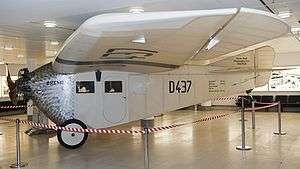Focke-Wulf A 16
| Focke-Wulf A.16 | |
|---|---|
 | |
| Role | Light passenger transport |
| Manufacturer | Focke-Wulf Flugzeugbau AG |
| Designer | Heinrich Focke Georg Wulf |
| First flight | 23 June 1924 |
| Produced | 20+ |
|
| |
The Focke-Wulf A.16 was a German three/four passenger light transport monoplane designed by Heinrich Focke and Georg Wulf and was first design built by the newly formed Focke-Wulf company.
Development
With the success of their earlier designs Focke and Wulf formed the Focke-Wulf company in 1924 and their first design was an all-wood three/four passenger airliner or light transport, the A.16, first flown by Georg Wulf on 23 June 1924. At least 20 aircraft were built; according to Airbus Industrie, Bremen, 23 were built. Airbus has built another one in the last 10 years, not airworthy, which is on display at Bremen Airport.
The A.16 was a high-wing cantilever monoplane of conventional configuration. The wing used a thick airfoil. The pilot sat in an open cockpit above the wing while the passengers were carried in the enclosed fuselage below. The tailskid undercarriage featured large wheels mounted on each side of the fuselage.
Variants
- A.16a
- Variant powered by a 100 hp (75 kW) Mercedes D.I engine.[1]
- A.16b
- Variant powered by an 85 hp (63 kW) Junkers L1a engine.[2]
- A.16c
- Variant powered by a 100 hp (75 kW) Siemens-Halske Sh 12 engine.[2]
- A.16d
- Variant powered by a 120 hp (89 kW) Mercedes D.II or D.IIa engine.[2]
Specifications (A.16c)
Data from The Illustrated Encyclopedia of Aircraft (Part Work 1982-1985), 1985, Orbis Publishing, Page 1835
General characteristics
- Crew: 1
- Capacity: 3–4
- Length: 8.5 m (27 ft 10 3⁄4 in)
- Wingspan: 13.90 m (45 ft 7 1⁄4 in)
- Height: 2.30 m (7 ft 6 1⁄2 in)
- Wing area: 27.1 m2 (291[3] ft2)
- Empty weight: 570 kg (1256 lb)
- Gross weight: 970 kg (2138 lb)
- Powerplant: 1 × Siemens-Halske Sh 11 7-cylinder radial piston engine, 56 kW (75 hp)
Performance
- Maximum speed: 135 km/h (84 mph)
- Range: 550 km (342 miles)
- Service ceiling: 2500 m (8200 ft)
References
- "The Focke-Wulf A.16: An Interesting German Commercial Aeroplane". Flight, 15 January 1925. Vol XVII, No. 838. pp. 27–28.
- Stroud, John. "Wings of Peace". Aeroplane Monthly, January 1987, Vol. 15, No. 1. pp. 40–45.
- The Illustrated Encyclopedia of Aircraft (Part Work 1982-1985), 1985, Orbis Publishing, Page 1835
External links
| Wikimedia Commons has media related to Focke-Wulf A 16. |
- www.histaviation.com: Focke-Wulf A16